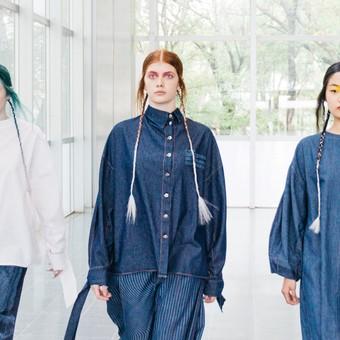If the fashion that comes is characterized by insisting on the fusion of technology and sustainability, Lucía Chain understood it to the letter.The clothing designer, graduated in the Faculty of Architecture, Design and Urbanism of the UBA, who participated in fashion weeks of Chile, Italy and Russia, is also a pioneer to work with materials generated with natural fibers and use tinctures that come fromNature, such as a beet or an onion.
Now, he does the same with Chain, his homonymous brand.The err.AR, presented in the digital edition of Designers BA, investigates new ways of producing and does so from the exploration in the potential of the denim, the fabric used to make jean pants, among several other garments.
"The future is not to fear the error," says the slogan of this capsule that he made in a strategic union with the historical company Ampargatas Textile- in charge of contributing the essential material for development- and in collaboration with Jeanology, the Spanish company that worksWith disruptive technologies in the treatment of denim, (as is the case of the laser) and that has the purpose of increasing productivity, reducing water and energy consumption, in addition to eliminating waste and harmful emissions for the ecosystem.
“Technology comes to optimize production, I think that is the great contribution;manages to simplify and systematize the use of resources, ”says the creator.The result?Garments that are characterized by using the Zero Waste philosophy, from which, each cut is made according to a strict calculation with the idea of avoiding fabric waste.
Thus, geometric silhouettes and simple lines are obtained, precisely, by the laser treatment that burns the indigo pigment to capture the desired designs without margin of error, and avoiding the washing processes that threaten the environment.

The collection also combines Denim's own qualities such as resistance and durability, with handmade details (embroidery, for example) frequent in Chain's typologies from the foundation of the brand in 2017.
"Within the most industrial and mass production there is also the hope of doing things in a non -harmful and aligned way to my values of respect and awareness," says the designer.
New denim?
In a worldwide context in which the textile industry is increasingly observed for being one of the main causes of pollution, and Denim's production receives the main accusations, the unfailing question is: how is this fabric rethinking?
“We have worked in a sustainable production system for a long time.The business group to which textile espadrilles belongs to the cotton that it uses in its fabrics from planting to traceable processes, ”replies the CEO Carlos Peñarrocha.
The manager also explains that cotton plantations are located a few kilometers from the industrial plant, "which significantly reduces the use of fossil fuels for merchandise transfer, minimizing the carbon footprint".
In addition, as detailed, in the cotton spin no waste is generated, since they are recovered and reused at 98%, destined to produce new yarn and textile by -products.Finally, to glue the tissues, 97% starch, a natural product and 100% biodegradable is used.And the water treated at the effluent plant is recovered and reused at 90% for irrigation.
The union of Chain with textile espadrialArgentine clothing.This new fusion is now thought as a renewal of that link.
While the emergence of Denim dates back to the seventeenth century and Jean's first pants created by Levi Strauss have more than 140 years of history in the clothing market, the truth is that contemporary fashion proposes to modernize this material in terms ofaesthetic, environmental and technological issues, and also seeks to acquire new meanings.
In that sense, Chain considers that the importance of this fabric is indissolubly associated with the popular sectors.Therefore, and since, generally, the clothing made under sustainable parameters is usually linked to luxury and an even elite idea, it argues that it is valuable to work with materials that are closer to the daily life of consumers to generate designs that are moreaccessible and for more people.
"And although the 100% cotton denim is aligned to the materials that I usually use, being worked in such a different way, that implies that it incorporates extra processes that grow not only the level of my products but also that of my image,"The designer points out.
How do you imagine the fashion of the future?And how do you think sustainability will be at the time of developing garments?"Much more inclusive, collaborative and respectful," he anticipates
Fashion and Recycling: They take advantage of silobolsas to make accessories
Why the diver is the new fetish garment
Luján Saez: It comes from a fashion family and launches its first collection at 15 years
Topics that appear in this note
Comments
Commenting Clarín's notes is exclusive to subscribers.
Subscribe to comment
I already have a subscription
Clarín
To comment you must activate your account by clicking on the e-mail we send you to the box, did you not find the e-mail?Click here and we send it to you again.
Clarín
To comment on our notes please complete the following data.
Basic Tips on How to Take Good Care of Your Feet
6 Items to Help You Start the Journey of Losing Weight
How to Save Money on Your Seaside Trip: Clever Tips for a Frugal Vacation That Won't Sacrifice Fun
Lil Nas X's Unofficial 'Satan' Nikes Containing Human Blood Sell Out In Less Than A Minute